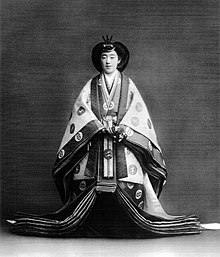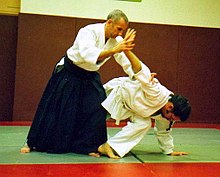Japanese traditional clothing
This article looks at traditional Japanese clothing ( Japanese 和服 Wafuku ) that has been passed down for centuries. The complement to this is called "Western clothing" ( 洋服 Yōfuku ).
Traditional outerwear
Jimbei
Jimbei ( 甚 兵衛 or 甚 平 ) is a traditional Japanese garment that is mainly worn by men and children in summer. Jimbei sets consist of a top and matching shorts.
A traditional Jimbei is made from hemp or cotton and dyed in a uniform color, usually blue or green. The top resembles a sleeveless or short-sleeved jacket that reaches down to the hips. It is worn either in or over pants. Traditional jimbei are often worn by men as a yukata substitute at summer parties.
Nowadays the Jimbei is often used as pajamas. Modern Jimbei are made from a variety of fabrics and also printed with patterns. This type of Jimbei includes a shorter jacket that is stretchy at the waist.
Jūnihitoe

The Jūnihitoe ( 十二 単 ) is a particularly elegant and complicated kimono , which was only worn by ladies of the Japanese imperial family. Literally translated, Jūnihitoe means "twelve-layer robe".
The Jūnihitoe first appeared in the 10th century during the Heian period . The different layers of the dress are made of silk . The innermost layer consists of white silk, followed by other layers, which have different names and are ultimately covered by a final layer or coat. The total weight can be up to 20 kg. The colors and the composition of the individual layers are very important. In addition, the colors have poetic names, such as “purple plum of spring”. The only places where the different layers of fabric are visible to the viewer are on the collar, on the sleeves and sometimes on the bottom of the dress. The composition and the colors of the different layers of fabric are good indicators for outsiders, because they reveal what taste and what rank the lady has.
Today, the Jūnihitoe can only be viewed in museums or films, because it has not been produced for a long time. These robes are considered to be priceless and one of the most expensive items of clothing in Japan. Only the Japanese imperial family still uses the Jūnihitoe for special occasions. During Princess Masako's wedding to Crown Prince Naruhito , Masako also wore a jūnihitoe. In addition, the Jūnihitoe was also used by Empress Michiko during the enthronement of Emperor Akihito in 1990 . Their ladies-in- waiting also wore the Jūnihitoe , but in a modified form from the Edo period , not in the Heian style .
kimono
Kimono is a traditional Japanese caftan-like item of clothing that is held together by a wide belt ( obi ).
Originally, the word kimono applied to all types of clothing.
Today's kimono took shape in the Heian period (794–1192). Since then, the basic shape of the kimono has remained largely unchanged for both men and women. A T-shaped, straight robe that reaches to the ankles, a collar and wide sleeves. If you stretch your arms out horizontally, the sleeves will fall from your wrist to about your hips (in some styles, the sleeves can even almost touch the floor). The robe is wrapped around the body, always with the left side over the right. The kimono is held together by a sash-like belt, the obi . It is tied at the back.
The kimono for women are essentially one size. They are clamped and folded to suit the individual physique. Nowadays, however, both men and women kimono are increasingly available in different sizes. Very tall or heavily built people (such as sumo wrestlers ) need a specially tailored kimono.
In the past, kimono were completely taken apart so that they could be washed in pieces. Then the parts were sewn back together. Modern washing methods and fabrics have made this procedure largely superfluous. Sometimes a folded kimono is basted with wide, loose stitches for storage. This prevents wrinkles or wrinkles from appearing while holding the different layers of the kimono together.
Over time there have been many variations in color, fabric and style, also in accessories such as the obi .
Hakama
The hakama is part of traditional Japanese outerwear . It is a trousers developed around 1600 that is worn over the Keiko-Gi and comes in two versions: with split legs like a culottes, or without a split like a skirt, and is now worn equally by women and men.
The hakama has its origin as leg protection for mounted samurai of the Edo period against bushes and undergrowth. Until World War II , it was perfectly normal to meet men in public in Hakama and Haori . After that, more and more Japanese people chose western clothing for everyday life. Nowadays, the Hakama is almost exclusively worn as formal clothing for ceremonies and shrine visits, in traditional Japanese dance and by artists (mostly without leg division) as well as in various martial arts (e.g. Aikido , Iaido , Kyūdō or Kendo ) (with leg division).
In martial arts circles, the seven folds of the hakama are often associated with the seven virtues of the samurai.
Yukata
A yukata is a traditional Japanese garment made of cotton . Above all, it serves as an uncomplicated, lighter and more everyday variant of the kimonos because it is easier to tie and cheaper. A yukata is put on after bathing in Japanese hotels or at summer festivals such as fireworks festivals . The yukata is also often used as pajamas .
Obi (belt)
Obi is the belt , e.g. B. also the kimono .
In Japanese martial arts it belongs to every keikogi (sportswear for budo sports) and is mostly used functionally to hold the uwagi (suit jacket) together and to hold the hakama. In Iaidō and Kenjutsu it is also used to carry the sword in its scabbard. In addition, it shows the level of progress of a fighter in many Budo sports.
Traditional footwear
Tabi (socks)
Tabi are ankle-high socks with a separate big toe.
They are usually worn to Zōri or Geta . White tabi are common; But men also occasionally wear black or dark blue ones. There are also patterned and colored tabi. However, these are rare. Today there are also stretch versions that are particularly close to the foot, which is considered aesthetic in Japan.
There is also a reinforced version of the tabi ( 地下 足 袋 , jika-tabi literally tabi that touch the ground ), often with a rubber coating on the sole, which can be worn without additional sandals or shoes. Traditionally, this type of tabi is worn by construction workers, carpenters, farmers or gardeners, for example, because they provide a better grip than zori.
Zōri (sandal)
Zōri are traditional Japanese sandals . They consist of a sole and two straps that run between the big and second toes. This is why socks with a split toe, the tabi, are worn with Zori .
There are simple to coarse zōri woven from rice straw, which used to be worn for everyday work, as well as a variant with a narrow, high sole, which is covered with fabric (now mostly plastic) and only worn by women, with a more elegant effect .
Today zōri are only worn with traditional clothing, e.g. B. at festivals or in Budo .
Geta (shoes)
Geta describes Japanese wooden shoes that are worn with traditional clothing such as the kimono . Typical for Geta are the high soles, which in Japanese culture, which has always regarded cleanliness as a high virtue, in earlier times kept the foot at a distance from the rubbish on the street.
Waraji
Waraji are Japanese sandals made from various permanent plant fibers (hemp, stems of Myōga - a type of ginger , Zingiber mioga ), palm fibers, cotton cords , rice straw, etc.) In ancient Japan they were the footwear of common people. In the course of the Gekokujō period, which was marked by peasant revolts, wearing waraji became more popular among samurai - just as fighting on foot became more popular. Nowadays they are primarily worn by traditionally oriented Buddhist monks.
Traditionally, the Japanese wear them with protruding toes, ie too short by European standards.
The waraji are tied in different ways (for example nakachi-nuki , yotsu-chigake and takano-gake ) depending on the purpose . A monk binds them differently than a peasant or a soldier or a townspeople.





